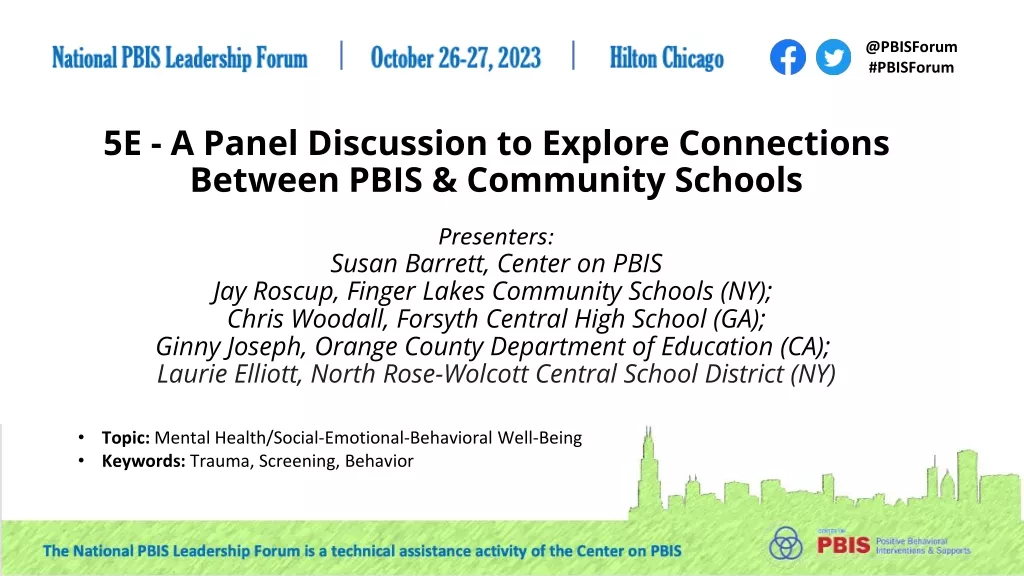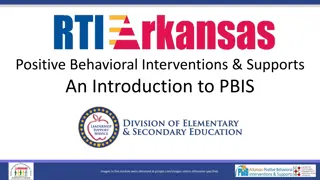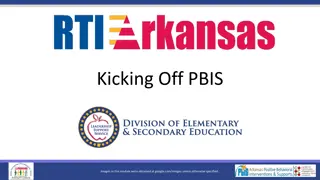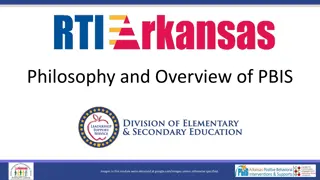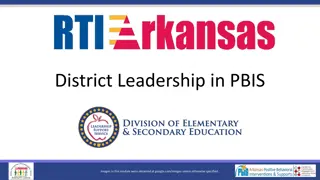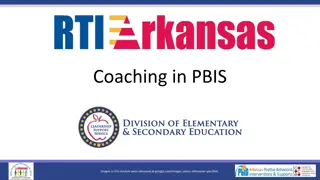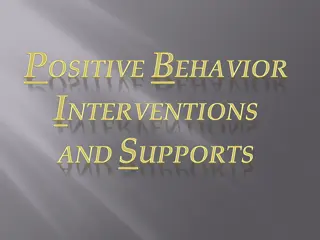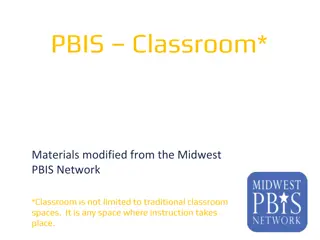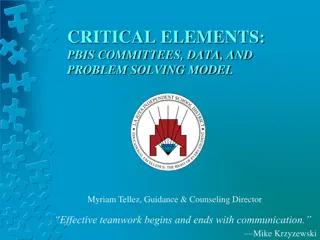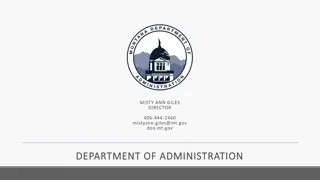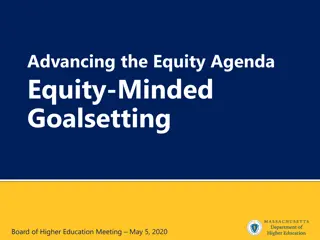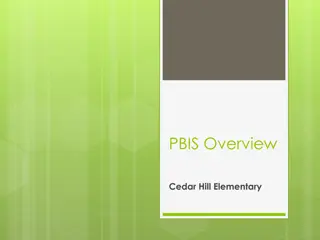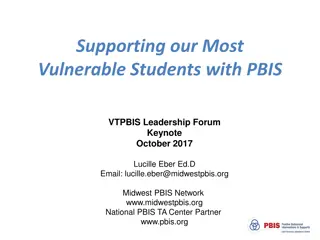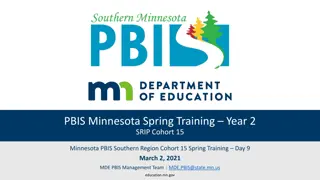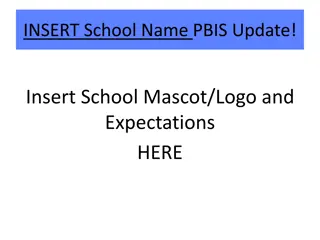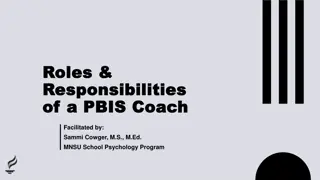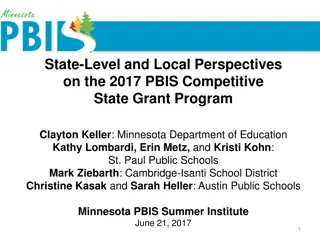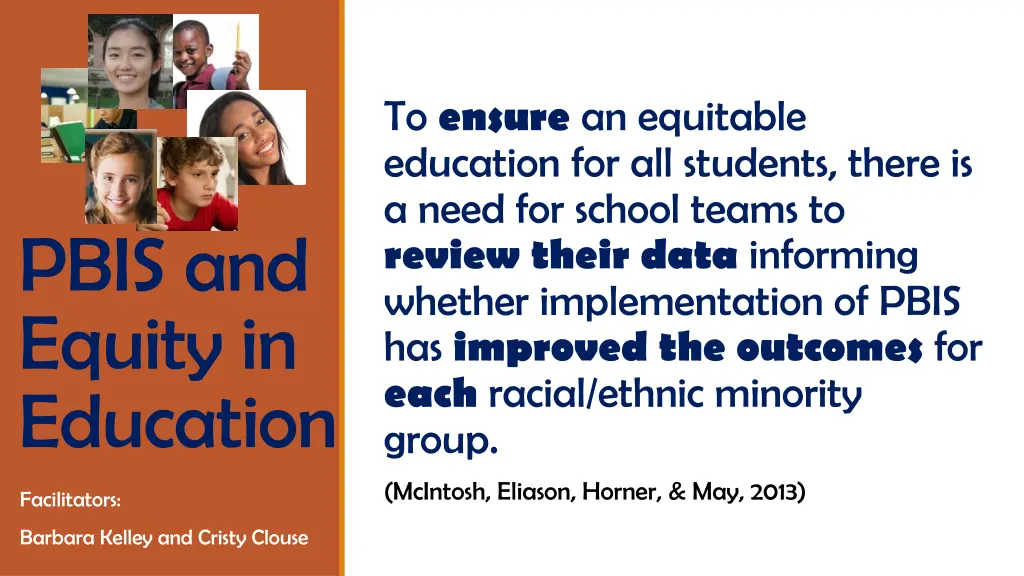
Improving Equity Through PBIS Data Review
School teams need to review data to assess the impact of PBIS implementation on outcomes for racial/ethnic minority groups in education, as discussed in the presentation by McIntosh, Eliason, Horner, & May (2013). The content emphasizes the importance of equity in education and the evaluation of PBIS effectiveness across different student demographics.
Download Presentation

Please find below an Image/Link to download the presentation.
The content on the website is provided AS IS for your information and personal use only. It may not be sold, licensed, or shared on other websites without obtaining consent from the author. If you encounter any issues during the download, it is possible that the publisher has removed the file from their server.
You are allowed to download the files provided on this website for personal or commercial use, subject to the condition that they are used lawfully. All files are the property of their respective owners.
The content on the website is provided AS IS for your information and personal use only. It may not be sold, licensed, or shared on other websites without obtaining consent from the author.
E N D
Presentation Transcript
To ensure an equitable education for all students, there is a need for school teams to review their data informing whether implementation of PBIS has improved the outcomes for each racial/ethnic minority group. PBIS and Equity in Education (McIntosh, Eliason, Horner, & May, 2013) Facilitators: Barbara Kelley and Cristy Clouse
Culturally Responsive Tier I Core Features Consequences for Problem Behavior Consequences for Problem Behavior System to Acknowledge Behavior System to Acknowledge Behavior Classroom Systems Classroom Systems School-wide Expectations School-wide Expectations Data and Decision System Data and Decision System Leadership Team Leadership Team Bully Prevention Bully Family Engagement Prevention
SWIS Three Point Perspective School Ethnicity Report Does an ethnic group receive referrals proportionate to their size in the school population? Percent of total referrals by ethnic group compared to percent of enrollment for that ethnic group. Latino students make up 24.60% of the school s total population and 28.68% of the school s total referrals come from Latino students.
SWIS Three Point Perspective School Ethnicity Report Of the students who have referrals in the school, does an ethnic group receive referrals proportionate to their size in the school population? Percent of students with referrals by ethnicity compared to percent of enrollment for that ethnic group. Latino students make up 24.60% of the school s total population and 29.97% of students in the school with referrals are Latino.
SWIS Three Point Perspective School Ethnicity Report Are ethnic groups being referred at the same rate? Number of students in a group with an ODR divided by total number of students enrolled in the group. 82.11% of the school s Latino students have had a referral and 64.71% of the school s White students have had a referral.
TO OFTEN Kent McIntosh, PhD University of Oregon National PBIS Center
GET GOING Talk at your table: What approaches have you tried to build a commitment to equity in your schools? How have they worked?
Intervention Approach McIntosh, Girvan, Horner, Smolkowski, & Sugai, 2014 Use engaging academic instruction to reduce the support gap (achievement gap) 2. Implement a behavior framework that is preventive, multi-tiered, and culturally responsive 3. Collect, use, and report disaggregated discipline data 4. Develop policies with accountability for disciplinary equity 5. Teach neutralizing routines for vulnerable decision points 1. http://www.pbis.org/school/equity-pbis
Inside Outside Circle Processing Activity Effective Instruction Teach neutralizing routines for VDP s http://www.pbis.org/school/equity-pbis Develop policies with accountability for Disciplinary Equity School- wide PBIS Collect, Use, Report Disaggregated Discipline data
Explicit Conscious belief that some groups aspire to desirable traits more than others Implicit Unconscious associations regarding some groups
Reduce the Effects of Implicit Bias Reduce ambiguity in ODR definitions and behavior referral process Clear definitions of problem behavior Clear guidelines for staff vs. teacher managed behaviors Identify specific vulnerable decision points National Data Local (district or school) Teach a neutralizing routine Self-Assess presence of VDP Use alternative response
What is a Vulnerable Decision Point (VDP)? A specific decision that is more vulnerable to effects of implicit bias. Two parts: oElements of the situation oThe person s decision state (internal state)
Options for Identifying VDP oDrill down ODR/Suspension/Expulsion Decisions oIdentify VDP s through National data oUse School or District Data
VDP DRILL DOWN FROM DISCIPLINE DATA School determine Disproportionality as a Red Flag Drill down race/ethnicity (Who) data by What Where When Who (gender specific) Why (perceived motivation) May identify multiple VDP s
VDPs from National Data Subjective Problem Behavior Defiance, Disrespect, Disruption Major (office managed) vs. Minor (teacher managed) Afternoons Classrooms
TWO STEP NEUTRALIZING ROUTINES FOR STAFF 1. When you see the problem behavior stop and ask yourself: Is this a VDP? Situation Decision State 2. If so, use an agree-upon alternative response
Neutralizing Routines for Reducing Effects of Implicit Bias Self Assessment Is this a Vulnerable Decision Point? Setting Event Lack of positive interactions with student Antecedent Loud complaints about work Behavior Send student to the office Consequence Student leaves class Escape assignment and social situation Fatigue Subjective behavior ODR Alternative Response See me after class and we can talk about it
What makes for a good neutralizing routine? 1. If-then statements (now-that) 2. Brief 3. Clear Steps 4. Doable 5. Interrupts the chain of events
Neutralizing Routines as Pre-Corrections Am I about to enter a VDP? What are my values? When I see problem behavior, I ll use the alternative response.
Disproportionality Drill Down Red Flag
Drill Down: Physical Aggression (what) on Playground (where) (Who)
Intervention ODRs and observations indicated differences in perceived basketball rules Team clarified rules for staff and students AKA code-switching Additional teaching, practice and acknowledgment Monitor with ODRs and Black-White Risk Ratios
Intervention Outcomes Black-White Risk Ratios Overall 2013-14: 2.67 2014-15(Sept to Dec.): 2.0 Physical Aggression on the Playground 2013-14: 4.5 2014-15(Sept to Dec): can t calculate (1 ODR)
What about the Administrator and Disproportionality? What is the strongest predictor of disproportionality in school discipline? The school principal s endorsement of exclusionary discipline and zero tolerance policies. (Skiba, Trachok, Chung, & Baker, 2012)
VDPs for Administrators When you have to handle problem behaviors stop and tell yourself 1. Don t just do something, stand there o Be sure you are ready to act in line with your values o Get information from student and staff o Assess student-teacher relationship 2. Whenever possible, use an agreed upon instructional response Teaches missing skill Connects student to school and staff
The Restorative Chat Tell me what happened. What you were thinking at the time? Who did this affect? What do you need to do about it? How can we make sure this doesn t happen again? What can I do to help you?
Culturally Conscious Self-Assessment www.edequity.com The purpose of the Culturally Conscious Positive Behavior Intervention Support (CCPBIS) survey is to identify key understanding of how culture impacts the educators knowledge, skills and action in implementing social/emotional and academic preventive support structures for diverse students. Consciousness Culture Caring Congruency http://ts4.mm.bing.net/th?id=I4597664383632967pid=1.5 http://ts4.mm.bing.net/th?id=I4597664383632967pid=1.5 http://ts4.mm.bing.net/th?id=I4597664383632967pid=1.5 http://ts4.mm.bing.net/th?id=I4597664383632967pid=1.5
PBIS and Equity in Education This 90 minute presentation will engage you in an evidence-based process to address disproportionality in behavior data and promote equity in your school. Learn about culturally responsive Tier I practices, Vulnerable Decision Points, Neutralizing Routines and Equitable Interventions. Participants will complete a Culturally Conscious Self-Assessment.

